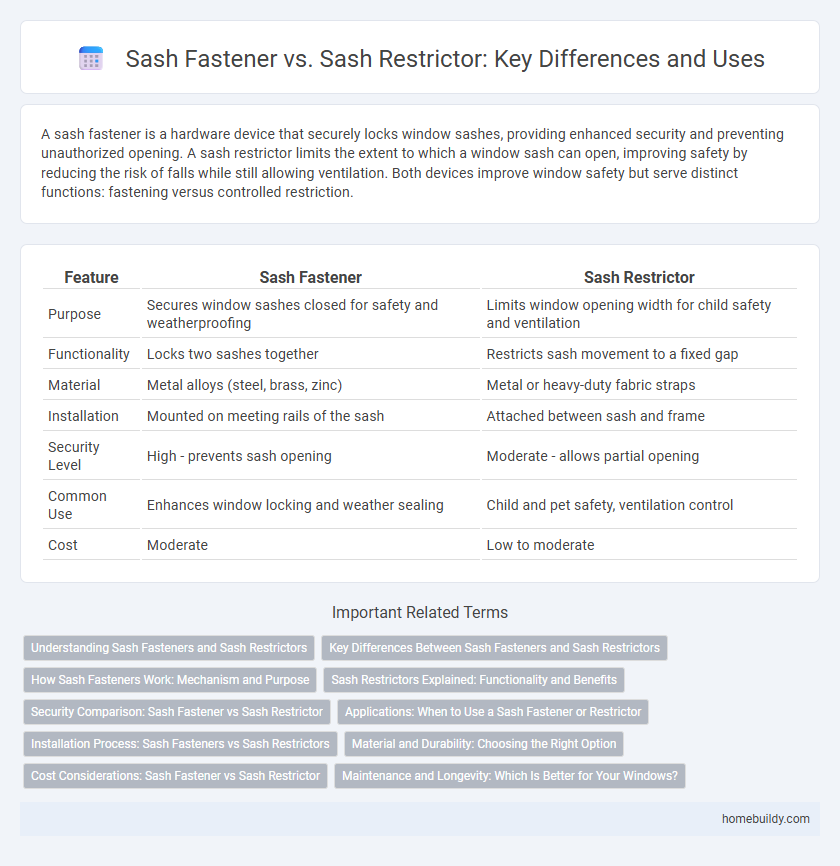A sash fastener is a hardware device that securely locks window sashes, providing enhanced security and preventing unauthorized opening. A sash restrictor limits the extent to which a window sash can open, improving safety by reducing the risk of falls while still allowing ventilation. Both devices improve window safety but serve distinct functions: fastening versus controlled restriction.
Table of Comparison
| Feature | Sash Fastener | Sash Restrictor |
|---|---|---|
| Purpose | Secures window sashes closed for safety and weatherproofing | Limits window opening width for child safety and ventilation |
| Functionality | Locks two sashes together | Restricts sash movement to a fixed gap |
| Material | Metal alloys (steel, brass, zinc) | Metal or heavy-duty fabric straps |
| Installation | Mounted on meeting rails of the sash | Attached between sash and frame |
| Security Level | High - prevents sash opening | Moderate - allows partial opening |
| Common Use | Enhances window locking and weather sealing | Child and pet safety, ventilation control |
| Cost | Moderate | Low to moderate |
Understanding Sash Fasteners and Sash Restrictors
Sash fasteners secure window sashes tightly, enhancing security and weather resistance by locking the movable parts together. Sash restrictors limit the opening range of a sash window, preventing accidents while maintaining ventilation without fully locking the window. Understanding the distinct functions of sash fasteners and sash restrictors helps in choosing the right hardware for safety, security, and functionality in window design.
Key Differences Between Sash Fasteners and Sash Restrictors
Sash fasteners primarily serve to securely lock windows, preventing them from being opened from the outside and enhancing security. Sash restrictors, on the other hand, limit the extent to which a window can open, providing controlled ventilation while maintaining safety, especially in homes with children. Key differences include the locking function of sash fasteners versus the movement-limiting purpose of sash restrictors, with fasteners focusing on security and restrictors emphasizing safety and controlled airflow.
How Sash Fasteners Work: Mechanism and Purpose
Sash fasteners operate by securely locking the window sashes together to provide enhanced security and prevent unwanted opening, using a cam or lever mechanism that tightly draws the sashes into alignment. This mechanism contrasts with sash restrictors, which limit the extent of window opening without fully locking the sashes. The primary purpose of sash fasteners is to ensure a tight seal for improved insulation and security, while sash restrictors focus on safety by controlling ventilation and preventing falls.
Sash Restrictors Explained: Functionality and Benefits
Sash restrictors enhance window safety by limiting how far a sash can open, preventing falls and unauthorized entry. Unlike sash fasteners, which secure windows shut, restrictors allow controlled ventilation while maintaining security. Their functionality adds a vital layer of protection especially in homes with children or multi-story buildings.
Security Comparison: Sash Fastener vs Sash Restrictor
Sash fasteners provide robust security by securely locking the window sash in place, preventing unauthorized opening and enhancing home protection. In contrast, sash restrictors limit the window opening size, allowing ventilation while deterring intrusions but offering less comprehensive security than fasteners. For superior protection against forced entry, sash fasteners are generally more effective due to their secure locking mechanism.
Applications: When to Use a Sash Fastener or Restrictor
Sash fasteners are ideal for securing windows tightly to improve insulation and security, making them suitable for traditional and modern timber frames. Sash restrictors limit the window opening for enhanced safety, particularly in homes with children or in public buildings to prevent falls. Choosing between a sash fastener and restrictor depends on whether the priority is secure closure or controlled ventilation and safety.
Installation Process: Sash Fasteners vs Sash Restrictors
Sash fasteners require secure attachment directly to the window sash and frame, involving screws and alignment for firm locking, often demanding precise measurements. Sash restrictors install between the sash and frame or on the side frames, typically mounted with screws or brackets to limit the window's opening range without fully locking it. The installation of sash fasteners is generally more complex, focusing on security, while sash restrictors prioritize controlled ventilation and safety with a simpler mounting process.
Material and Durability: Choosing the Right Option
Sash fasteners are typically made from robust metals such as brass or stainless steel, offering exceptional durability and resistance to wear and corrosion, ideal for long-term use in window security. Sash restrictors often utilize lighter materials like zinc alloy or plastic composites, prioritizing ease of use and flexibility but sacrificing some durability compared to sash fasteners. Selecting between a sash fastener and sash restrictor depends on the balance of material strength and lifespan requirements for your specific window safety and security needs.
Cost Considerations: Sash Fastener vs Sash Restrictor
Sash fasteners generally offer a more affordable option compared to sash restrictors, making them suitable for budget-conscious window security solutions. While sash restrictors provide enhanced safety features by limiting window opening, their advanced mechanisms typically increase the overall cost. Choosing between a sash fastener and a sash restrictor depends on balancing budget constraints with desired security and functionality.
Maintenance and Longevity: Which Is Better for Your Windows?
Sash fasteners typically require less maintenance than sash restrictors due to their simpler mechanical design, reducing the risk of wear and tear over time. Sash restrictors, while enhancing window safety, involve more components that may need regular inspection and lubrication to ensure longevity. Choosing a sash fastener can optimize window durability and minimize upkeep, ultimately extending the lifespan of your window hardware.
Sash fastener vs Sash restrictor Infographic

 homebuildy.com
homebuildy.com